Digitip 027 – Adobe InDesign CS
A little while ago one of my customers (a Pica Award winner), presented me with a graphic design in which a facing pages document had no pagenumbering on the left hand page, yet double page numbering on the right hand page (indicating the left-page number and right-page number). The question was: Could this be automated? I must admit it tested my creative thinking, but a solution was found, which is outlined in the following tip.
Master page setup
Start by creating a new document, and select the facing pages option. Or alternatively work with island spread master pages. In your pages palette double click the A Master.
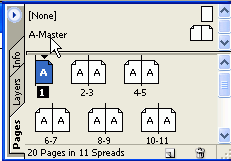
Your document will then display a page spread.
Two text boxes
On the left hand page draw a text frame (click drag with the type tool), then using the selection tool, click the outport on the previously drawn frame and create a second frame on the right hand page.
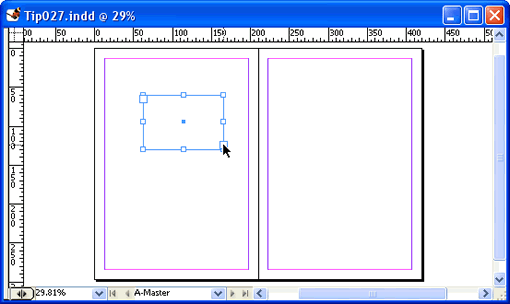
The two frames are now linked. Double click with your selection tool in the first frame to see the text insertion cursor.
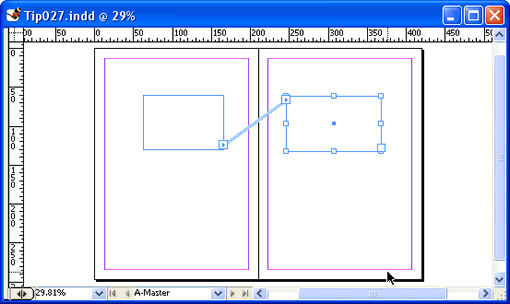
The page numbers
Now that the text cursor is flashing away, let’s force it to jump to the text frame on the right hand page, by selecting Insert Break Character > Frame Break (right mouse click or if you’re on a mac with a single mouse buttone, Ctrl-click).
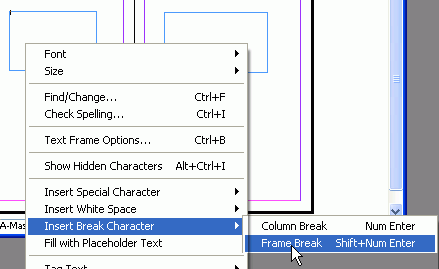
Now we are ready to include our (automatic) previous page number marker. Right mouse click and select Previous Page Number from the Insert Special Character contextual menu. Enter any character that sits between the two page numbers. I’m inserting a pipe-character. (|) Right mouse click again, and select Auto Page Number from the Insert Special Character contextual menu that appears.

So now we have two “A”‘s in our master page indicating some automatic numbering occurring in A-Master (hence the letter A).
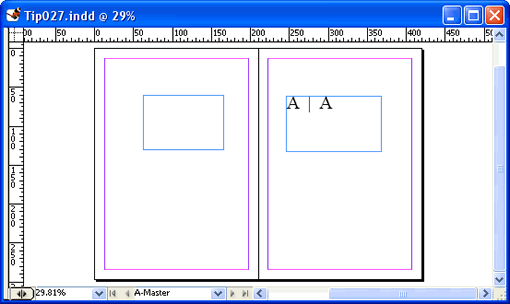
Finally the proof is in the pudding…
Let’s view our document pages 2 and 3…
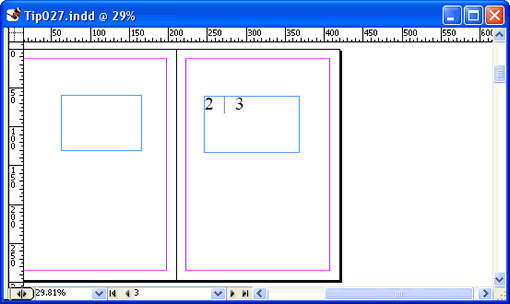
Ok, so now you go to page 1 and notice the PB listed as the previous number. You’ll have to manually remove that after overriding this master page element (Shift Ctrl click on PC, Shift-Command click on Mac).
Now try and use this technique with next page numbers as well… 🙂
the same problem. a indesign cs3 job open then at indesign cs4 shows wrong numbering 🙁
Hi Trebreh,
See my CS4 specific post for this page numbering tip @ http://carijansen.com/2009/06/07/tip-087/
I hope it will help resolve the issue.
Cheers,
Cari
Hi Cristina, maybe you are inserting only the current page number and that is the reason why you get the 3 | 3. To work I place after the first Current Page Number and type a separator like “|” and then insert a Next Page number to get different page numbers (Current and Next Page numbers), whith this you get a 3 | 4.
Hi Cristina, Did Alfredo’s tip help out? I have tested this in CS4 and it does work indeed. The main thing is that the text frames ARE threaded and you are inserting the correct Markers.
My text frames are threaded, inserted the Currente page number and still doesn´t work I get for exemple 3 | 3
Thanks
I must also do the same with CS4, I follow all the directions but still does not work.
I always like the page number for example 10 / 10
Can you help me
thanks
Are the two text frames on the Master indeed threaded?
Dear Cari
I tried to replicate this in InDesign CS4 and it doesn´t work
Can you help me
Thanks
Hi Cristana,
I just tested this in CS4 and it definitely still works. But a few things are in different spots and now named differently.
You can find the page number markers under Type > Insert Special Character > Markers
Instead of “Auto Page Number” listed above use Current Page Number
Hope you’ll get it working now.
Cheers,
Cari